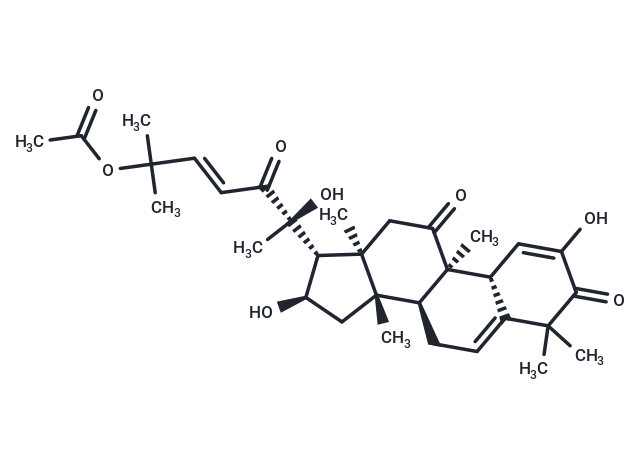Shopping Cart
Remove All Your shopping cart is currently empty
Your shopping cart is currently empty
Cucurbitacin E is a natural product isolated from the climbing stem of Cucumic melo L. It significantly suppresses the activity of the cyclin B1/CDC2 complex.Cucurbitacin E has prevention of neurodegeneration, it has potent anti-proliferative, antineoplastic, anti-inflammatory and analgesic actions.

| Pack Size | Price | USA Warehouse | Global Warehouse | Quantity |
|---|---|---|---|---|
| 1 mg | $54 | In Stock | In Stock | |
| 5 mg | $117 | In Stock | In Stock | |
| 10 mg | $187 | In Stock | In Stock | |
| 25 mg | $316 | In Stock | In Stock | |
| 50 mg | $469 | In Stock | In Stock | |
| 100 mg | $677 | In Stock | In Stock | |
| 1 mL x 10 mM (in DMSO) | $143 | In Stock | In Stock |
| Description | Cucurbitacin E is a natural product isolated from the climbing stem of Cucumic melo L. It significantly suppresses the activity of the cyclin B1/CDC2 complex.Cucurbitacin E has prevention of neurodegeneration, it has potent anti-proliferative, antineoplastic, anti-inflammatory and analgesic actions. |
| In vitro | the anti-proliferation and cell cycle G2/M arrest induced by Cucurbitacin E (CuE)?in CRC cells.?MPM-2 flow cytometry tests show that CuE-treated cells accumulated in metaphase (CuE 2.5-7.5 μM).?CuE produced G2/M arrest as well as the downregulation of CDC2 and cyclin B1 expression and dissociation.?Both effects increased proportionally with the dose of CuE;?however, the inhibition of proliferation, arrest of mitosis, production of reactive oxygen species (ROS), and loss of mitochondrial membrane potential (ΔΨm) were found to be dependent on the quantity of CuE used to treat the cancer cells.?In addition, cell cycle arrest in treated cells coincided with the activation of the gene GADD45(α, β, γ).?Incubation with CuE resulted in the binding of GADD45γ to CDC2, which suggests that the delay in CuE-induced mitosis is regulated by the overexpression of GADD45γ.?CuE may have antitumor activities in established CRC[3]. |
| Molecular Weight | 556.69 |
| Formula | C32H44O8 |
| Cas No. | 18444-66-1 |
| Smiles | CC(=O)OC(C)(C)\C=C\C(=O)[C@](C)(O)[C@H]1[C@H](O)C[C@@]2(C)[C@@H]3CC=C4[C@@H](C=C(O)C(=O)C4(C)C)[C@]3(C)C(=O)C[C@]12C |
| Relative Density. | 1.24g/cm3 |
| Color | White |
| Appearance | Solid |
| Storage | Powder: -20°C for 3 years | In solvent: -80°C for 1 year | Shipping with blue ice/Shipping at ambient temperature. | ||||||||||||||||||||||||||||||
| Solubility Information | DMSO: 55 mg/mL (98.8 mM), Sonication is recommended. | ||||||||||||||||||||||||||||||
| In Vivo Formulation | 10% DMSO+90% Corn Oil: 2.5 mg/mL (4.49 mM), Sonication is recommeded. Please add the solvents sequentially, clarifying the solution as much as possible before adding the next one. Dissolve by heating and/or sonication if necessary. Working solution is recommended to be prepared and used immediately. The formulation provided above is for reference purposes only. In vivo formulations may vary and should be modified based on specific experimental conditions. | ||||||||||||||||||||||||||||||
Solution Preparation Table | |||||||||||||||||||||||||||||||
DMSO
| |||||||||||||||||||||||||||||||
| Size | Quantity | Unit Price | Amount | Operation |
|---|

Copyright © 2015-2025 TargetMol Chemicals Inc. All Rights Reserved.